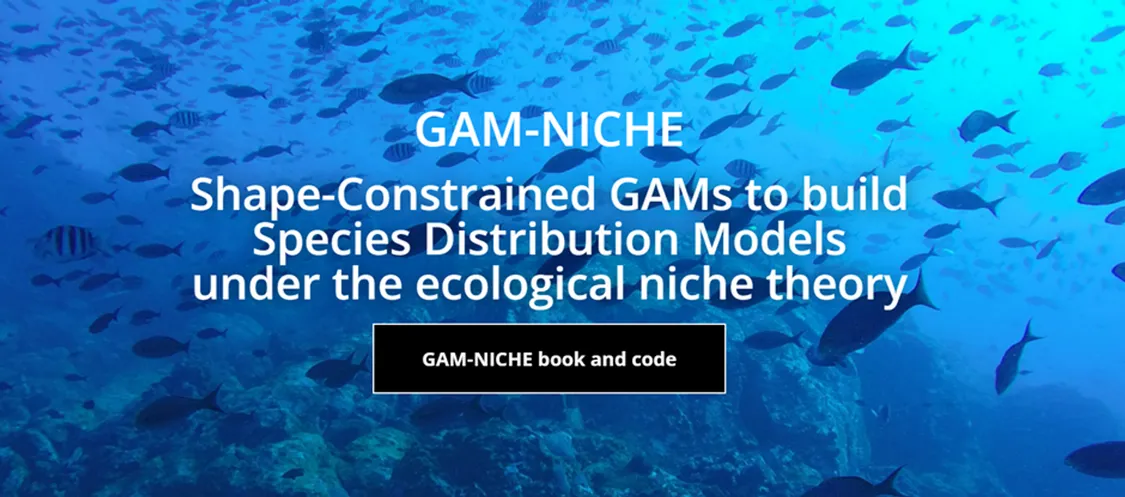By Guillem Chust (AZTI) and Caecilia Manago (ERINN Innovation)
GAM-NICHE is a new open access tool developed by AZTI (Valle et al. 2023) to build Species Distribution Models (SDMs) under the ecological niche theory (Citores et al. 2020). It provides a GitHub tutorial in R language with an application to marine species. The tutorial provides guidance on how to use shape-constrained generalized additive models (SC-GAMs) to build SDMs under the ecological niche theory framework, based on the development and application to marine fish by Citores et al. (2020).
GAM-NICHE was launched officially as MISSION ATLANTIC tool supporting Integrated Ecosystem Assessment (IEA)operations, on 6th October 2023 at the third Mission Atlantic General Assembly in Florianopolis, Brazil.

Presentation by Guillem Chust (AZTI) "GAM-NICHE: A new tool based on Shape-Constrained GAMs to build Species Distribution Models under the ecological niche theory" on Day 3, themed “Digital Ocean” on 6th October 2023 at the third Mission Atlantic General Assembly in Florianopolis, Brazil. Photo credit: Caecilia Manago (ERINN Innovation).
As described on the GAM-NICHE Website by AZTI (https://gam-niche.azti.es/), Species Distribution Models (SDMs) are numerical tools that combine observations of species occurrence or abundance at known locations with information on the environmental and/or spatial characteristics of those locations. SDMs are widely used as a tool for understanding species spatial ecology and are also known as ecological niche models (ENM) or habitat suitability models. According to ecological niche theory, species response curves are unimodal with respect to environmental gradients (Hutchinson 1957). While a variety of statistical methods have been developed for species distribution modelling, a general problem with most of these habitat modelling approaches is that the estimated response curves can display biologically implausible shapes which do not respect ecological niche theory. This is because species response curves are fit statistically with any assumption or restriction, which sometimes do not respect the ecological niche theory. To better understand species response to environmental changes, SDMs should consider theoretical background such as the ecological niche theory and pursue the unimodality of the response curve with respect to environmental gradients.
WHAT IS IT FOR?
- Marine and terrestrial species
- Estimation of species distribution, recruitment, spawning, cartography
- Determining main factors affecting a species
- Monitoring and trend analysis
- Restoration (identification of suitable areas)
- Shifts in biodiversity
- Climate change studies (projections, impacts, vulnerability, adaptation)
- Conservation: definition of areas to protect
- Assessment of anthropogenic pressures
- Identification of (un)exploited areas
Check out the following links for further reading, information and access to GAM-NICHE:
MISSION ATLANTIC web tools, supporting IEA operations, Case Study interactions, and stakeholder engagement: https://missionatlantic.eu/tools/
GAM-NICHE: Shape-Constrained GAMs to build Species Distribution Models under the ecological niche theory: https://gam-niche.azti.es/
GAM-NICHE book: https://fundacion-azti.github.io/gam-niche/
GAM-NICHE code: https://github.com/Fundacion-AZTI/gam-niche

GAM-NICHE: Shape-Constrained GAMs to build Species Distribution Models under the ecological niche theory: https://gam-niche.azti.es/
REFERENCES
- Citores, L., L. Ibaibarriaga, D. J. Lee, M. J. Brewer, M. Santos, and G. Chust. 2020. “Modelling Species Presence–Absence in the Ecological Niche Theory Framework Using Shape-Constrained Generalized Additive Models.” Ecological Modelling 418: 108926. https://doi.org/10.1016/j.ecolmodel.2019.108926.
- Elith, Jane, and John R. Leathwick. 2009. “Species Distribution Models: Ecological Explanation and Prediction Across Space and Time.” Journal Article. Annual Review of Ecology, Evolution, and Systematics 40 (1): 677–97. https://doi.org/10.1146/annurev.ecolsys.110308.120159.
- Hutchinson, G. E. 1957. “Concluding Remarks.” Journal Article. Cold Spring Harbor Symposia on Quantitative Biolog 22: 415–27.
- Valle, M., Citores, L., Ibaibarriaga, L., & Chust, G. (2023). GAM-NICHE: Shape-Constrained GAMs to build Species Distribution Models under the ecological niche theory. AZTI. https://doi.org/10.57762/FZPY-6W51.
